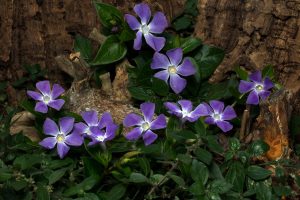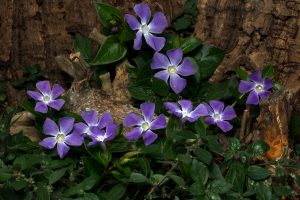Vinca Minor, commonly known as periwinkle, is a hardy evergreen ground cover plant that thrives in various soil types and environmental conditions. Known for its beautiful purple or blue flowers and glossy green leaves, Vinca Minor is a popular choice among gardeners for ground cover, landscaping, and adding color to shaded areas.
However, like all plants, Vinca Minor is not immune to problems, and one of the most common concerns gardeners face is the yellowing of the leaves. This phenomenon can be attributed to a variety of causes, each needing a different approach to solve.
In this article, we will discuss the 10 best reasons why the leaves on your Vinca Minor are turning yellow and how to address each issue effectively. By understanding these causes and solutions, you will be equipped to restore the health and vibrancy of your Vinca Minor.
Why Are the Leaves on My Vinca Minor Turning Yellow? 10 Best Reasons
1. Overwatering or Poor Drainage
One of the most common reasons for yellowing leaves in Vinca Minor is overwatering. Vinca Minor thrives in well-drained soil, and when it is consistently exposed to excess moisture, the roots can become waterlogged, leading to oxygen deprivation. This can result in stress to the plant, causing its leaves to yellow.
Solution: Ensure that your Vinca Minor is planted in well-drained soil. If the soil doesn’t drain well, consider adding organic matter such as compost to improve its structure. Avoid watering the plant too frequently, allowing the soil to dry out slightly between waterings. Additionally, consider planting Vinca Minor in elevated beds or containers with proper drainage holes to prevent root rot.
2. Nutrient Deficiency
Vinca Minor requires a balanced supply of nutrients, particularly nitrogen, iron, and magnesium, to maintain healthy foliage. A deficiency in these essential nutrients can cause the leaves to turn yellow, often starting from the tips and edges.
Solution: Conduct a soil test to determine the nutrient levels. If a deficiency is detected, apply a balanced fertilizer with micronutrients, such as one containing magnesium and iron. Slow-release fertilizers are a good choice, as they provide nutrients gradually over time. Be cautious not to over-fertilize, as this can lead to further stress on the plant.
3. Soil pH Imbalance
The pH of the soil plays a significant role in the availability of nutrients to the plant. If the soil is too acidic or alkaline, Vinca Minor may have difficulty absorbing essential nutrients, leading to yellowing leaves.
Solution: Vinca Minor prefers slightly acidic to neutral soil (pH 6.0 to 7.0). To determine the pH of your soil, use a soil pH testing kit. If the soil is too acidic, add lime to raise the pH, and if it’s too alkaline, add sulfur to lower it. Adjusting the pH will help ensure that the plant can access the nutrients it needs to thrive.
4. Pest Infestation
Various pests can damage Vinca Minor, leading to yellowing leaves. Common culprits include aphids, spider mites, and whiteflies, which feed on the plant’s sap and weaken the plant over time. These pests may also introduce diseases that exacerbate the problem.
Solution: Inspect your Vinca Minor regularly for signs of pests. If you notice small insects, webs, or sticky residue on the leaves, treat the plant with insecticidal soap or neem oil. For severe infestations, consider using chemical pesticides, but always follow the manufacturer’s instructions to avoid harming beneficial insects or the plant.
5. Fungal Diseases
Fungal infections, such as powdery mildew or root rot, can cause the leaves of Vinca Minor to yellow. Fungal diseases thrive in damp, humid conditions, and can spread quickly if not addressed.
Solution: Improve airflow around the plant by thinning out dense foliage and avoiding overhead watering, which encourages fungal growth. If you suspect a fungal infection, remove and dispose of affected leaves. Treat the plant with a fungicide labeled for use on perennials and follow the application instructions carefully.
6. Environmental Stress
Vinca Minor is a resilient plant, but it can experience stress due to extreme environmental conditions. Factors such as intense sunlight, strong winds, or sudden temperature changes can cause the plant to react by turning its leaves yellow.
Solution: If your Vinca Minor is exposed to excessive sunlight or heat, provide some shade, especially during the hottest part of the day. If planting in containers, consider moving the plant to a more sheltered location. Protect the plant from wind by placing it near a fence or other structures that block the wind.
7. Root Damage or Compaction
Roots that are damaged or confined to a small space can restrict the flow of water and nutrients to the plant, resulting in yellowing leaves. This can happen if the plant is grown in a container that is too small or if the soil becomes compacted over time.
Solution: Ensure that your Vinca Minor has enough room for its roots to spread out and grow. If the plant is in a pot, consider transplanting it into a larger container with drainage holes. In garden beds, regularly aerate the soil to prevent compaction and allow the roots to access air and nutrients more effectively.
8. Underwatering
While overwatering is a common cause of yellowing leaves, underwatering can also lead to similar symptoms. When Vinca Minor does not receive enough water, it becomes stressed, causing its leaves to turn yellow and eventually drop off.
Solution: Water your Vinca Minor deeply, ensuring that the soil is moist but not soggy. Allow the soil to dry out slightly between waterings, as overwatering can exacerbate the problem. During periods of drought, increase watering frequency to keep the plant hydrated.
9. Transplant Shock
If you’ve recently transplanted your Vinca Minor, it may experience transplant shock, which can cause its leaves to yellow. The stress of being moved from one location to another can temporarily disrupt the plant’s ability to absorb nutrients and water.
Solution: To reduce transplant shock, water the plant thoroughly before and after transplanting. Consider adding a rooting hormone to the soil to encourage root growth. Protect the plant from harsh sunlight and extreme weather conditions for the first few weeks after transplanting to help it adjust.
10. Aging or Natural Leaf Shedding
Finally, it’s important to remember that yellowing leaves can simply be a natural part of the plant’s lifecycle. As Vinca Minor matures, older leaves may turn yellow and drop off, especially during periods of dormancy.
Solution: If the yellowing is only affecting older leaves, this is likely a natural process and not a cause for concern. Simply prune the yellowing leaves to maintain the plant’s appearance. However, if the yellowing is widespread and affects younger leaves, it may indicate an underlying issue that requires attention.
Why Are the Leaves on My Vinca Minor Turning Yellow (FAQs)
- Why are the leaves on my Vinca Minor turning yellow in winter?
- Vinca Minor is an evergreen plant, but it can still experience yellowing leaves during the colder months due to reduced sunlight or overwatering. Ensure proper drainage and monitor water levels during winter months.
- How do I know if my Vinca Minor is getting too much water?
- If the leaves are turning yellow and the soil is constantly wet, it’s a sign that the plant is being overwatered. Reduce watering and ensure proper drainage.
- Can I use a chemical pesticide to treat pests on my Vinca Minor?
- Yes, chemical pesticides can be effective for severe infestations. However, always follow the instructions carefully and consider using organic options like neem oil for a safer, eco-friendly approach.
- What is the best fertilizer for Vinca Minor?
- A balanced fertilizer with micronutrients such as magnesium and iron is ideal for Vinca Minor. Look for a slow-release formula to provide nutrients over time.
- How can I improve the soil for my Vinca Minor?
- Adding organic compost can improve the soil structure, increase drainage, and provide essential nutrients for your Vinca Minor to thrive.
- Should I remove yellow leaves from my Vinca Minor?
- Yes, removing yellowing or damaged leaves can help improve the appearance of the plant and prevent the spread of potential diseases.
- How often should I water my Vinca Minor?
- Water your Vinca Minor when the top inch of soil feels dry. Be careful not to overwater, as this can lead to root rot and yellowing leaves
Conclusion
Yellowing leaves on your Vinca Minor can be caused by a variety of factors, including overwatering, nutrient deficiencies, pests, fungal diseases, and environmental stress.
By identifying the underlying cause and taking the appropriate steps to address it, you can restore the health of your plant and ensure that it continues to thrive in your garden.
Regular maintenance, proper watering, and pest control are key to keeping your Vinca Minor lush and vibrant.
By following the tips and solutions outlined in this article, you will be well on your way to a healthy, flourishing Vinca Minor that enhances your garden year-round.
Recent Posts
Indoor plants not only enhance your home décor but can also protect your living spaces from unwanted insects. Certain species emit natural compounds that deter pests like mosquitoes, flies, and...
Japanese maples (Acer spp.) are prized for their vibrant foliage, elegant structure, and year‑round ornamental appeal. When grown in containers, their health and coloration depend heavily on the...